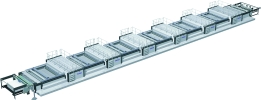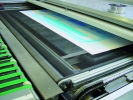
The switch from mechanical to electronic drive solutions offers a number of benefits for both machine builders and users of the machines. Making the switch, however, involves more than simply removing the mechanical line shaft and adding a few servo axes; it often requires partial or even complete redesign of the machine, since conventional technology increasingly reaches the limits of its capabilities.
Thieme, a company based in Teningen, Germany, has been producing screen printing systems since 1976. The design brief for its new Thieme 5000 XL screen printing machine was as simple as it was ambitious: exceptional production capacity combined with minimum labour overheads.
One of the biggest challenges was the large-scale printing format of up to 2 by 3,05 m. When the engineers set to work they soon realised that with this format many of the components used in previous systems, such as the central drive system and the mechanical line shaft, would simply be too big. It just would not have been possible to integrate them into the machine design properly. After analysing a number of alternatives it became clear that the combination of a motion controller with servo drives would be the best solution.

Translating the mechanical solution
One of the key requirements was to translate the existing mechanical solution as precisely as possible to the new system, this to keep development overheads low despite the complete redesign of the drive concept, and thus avoid losing the years of development invested in tried-and-tested movement sequences. To solve this problem the Thieme team chose a Melsec System Q motion controller from Mitsubishi Electric.
This controller's programming language can implement existing mechanical solutions with graphical representations. In addition, it combines motion control, PLC and IPC modules on a single platform, which means it can handle other machine control requirements as well as motion control. This eliminates the need for duplicate system racks, power supply units and other components. Another advantage of the fully integrated automation platform is that operators have complete and easy access to all PLC and motion controller data. Every CPU in the system has access to all data via the common backplane bus, so there is no need for time-consuming additional communications programming. The architecture also eliminates the need for a network connection between the two controllers.

Virtual programming
In the new system, the former main drive was programmed as a virtual servomotor connected to a virtual line shaft. The 30 axes (for a six-colour machine) were correctly placed in their positions using a simple 'drag-and-drop' operation. In addition to simple axes, the system can program virtual equivalents of numerous other mechanical components, including transmissions, roller feeders, linear axes and cam discs. This makes it possible to program the drives to perform complex movements, precisely synchronised with one another.
In contrast to earlier conventional solutions, in which the mechanical connections could only be interrupted with additional couplings, it is now possible to operate individual axes independently of the rest of the machine. For example, in the past the two printing units lifting drives were synchronised by being coupled to the line shaft. In the new THIEME 5000 XL screen printing system these drives are uncoupled during the printing process. The other machine processes continue to run during the printing sequence, optimising use of available time. Afterwards, the printing unit lifting drives are again synchronised with the virtual line shaft via the addressable couplings, and the two servo motors in each drive are always perfectly synchronised. Operation of individual axes without line shaft synchronisation is also necessary for installation, maintenance and repairs-previously the only way to achieve this was by physically uncoupling the mechanical axes, a time-consuming process.
With the motion controller, all that is needed is for set-up mode to be selected and all the servo drives can be operated independently of the virtual line shaft, a process that takes a few minutes of programming. The use of virtual cam discs makes the machines more flexible and improves the cost-benefit ratio. Optimised motion profiles for different printing materials are selected at the touch of a button. In the past this was not possible because of the expense of having to build and install new cam discs every time the printing material was changed.
The new solution significantly improves parts of the system not involved in motion control; the electronic cam controller allows all the other functions, such as switching the vacuum fields, to be adjusted much more flexibly. In addition, the deployment of the Mitsubishi motion controller has made it possible to add a wide range of valuable functions throughout the machine. These have included a single printing function for the individual printing units, teaching functions (for example, making adjustments for different printing formats) and a significantly more capable set-up function for switching to different printing screens.

System of servo motors and amplifiers
The integration capability of System Q was not the only reason for choosing the motion control system; Mitsubishi's ability to deliver a complete solution, including the drives, was equally important. One of the specifications was that the drives had to have compact servo amplifiers, because the engineers wanted to reduce the footprint of the machine and integrate the switchgear cabinet into the limited space in the machine bed. Another advantage of the servo drives that were chosen is that they come with absolute position encoders as standard. This makes it possible to continue printing immediately after emergency stops and other interruptions as the drives automatically register their positions as soon as power returns. In addition, the new solution has eliminated the need to rewire every time the switchgear cabinet is moved, when the printing system is modified or expanded.
Integrated automation concept
The fact that the solution was an integrated system from a single manufacturer was particularly helpful when it came to designing the machine's operation concept. Its full integration enables easy access to all system components from every control console. For example, operators program all squeegee pressure functions directly at the control console, eliminating the need for time-consuming manual adjustments.
High availability and fast setting up
Advanced motion control technology allowed the engineers at Thieme to develop a new generation of screen printing machines, THIEME 5000 XL. The new machines achieve continuous availability of 95% and, more importantly, cut set-up times to less than five minutes per printing station.
CBI is the authorised distributor of the Mitsubishi Electric range of products. This range includes programmable logic controllers (PLCs), human machine interfaces (HMIs), variable speed drives (VSDs), servo drives, motion control and Mitsubishi motor control equipment (ie, magnetic contactors, medium and high voltage vacuum contactors, thermal overload relays and electronic motor protection relays). A qualified team of sales engineers is able to advise customers and supply back-up support and service. All products carry a 12 month warranty.

© Technews Publishing (Pty) Ltd | All Rights Reserved